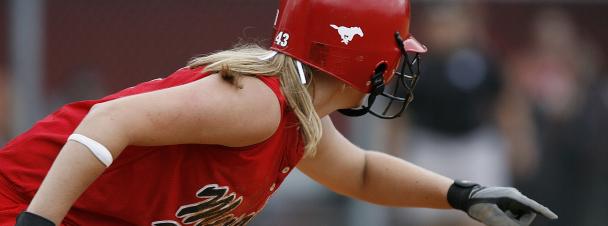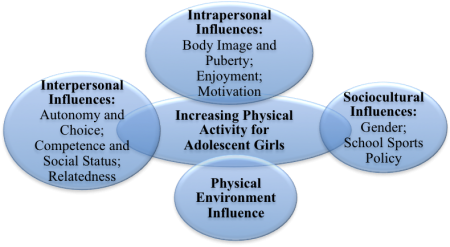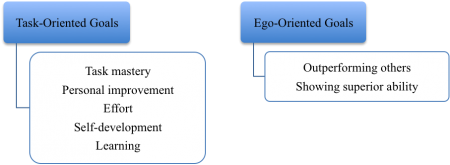Run, Jump, Throw! Getting Adolescent Girls on the Go

Previously published in Volume 84, Issue 3
Abstract
Research from the last ten years indicates that “adolescence is a risk period for physical activity attrition, particularly among girls” (Davison, Werder, Trost, Baker, & Birch, 2007, p. 2392). By the time most girls enter puberty, approximately 80% have already fallen to insufficient levels of physical activity for the maintenance of health and overall wellness (Davison et al., 2007; Voskuil, Frambes, & Robbins, 2017). Physical activity among adolescents has many health benefits including lower rates of obesity, higher bone density, better physical fitness, and improved psychological health, including body image (Davison et al., 2007). Schools are a key setting for promoting, facilitating, and providing opportunities for physical activity and “Identifying the factors…that are associated with young people’s physical activity can reveal promising determinants and lead to more effective intervention strategies” (Haug, Torsheim, Sallis, & Samdal, 2008, p. 249). The purpose of this appreciative inquiry is to identify and explore themes that contribute to the creation of a safe and supportive physical education (PE) environment for girls from grades 6-12 in order to encourage enthusiastic movement and engagement. The themes that emerged from this inquiry include body image and puberty, enjoyment, motivation, autonomy and choice, competence and social status, relatedness, gender, school sports policy, and the physical environment.
Guidelines established by the World Health Organization say that adolescents should engage in 60 minutes of moderate to vigorous physical activity on most days (Physical activity, n.d.). Yet research from the last ten years states that by the time most girls enter puberty, approximately 80% have already reached insufficient levels of physical activity for the maintenance of health and overall wellness (Davison et al., 2007; Voskuil et al., 2017). With adolescent girls spending a higher percentage of their time engaged in moderate to vigorous activity during school hours rather than after school (Cohen, Scott, Wang, Mckenzie, & Porter, 2008), and with the availability of facilities in schools, PE and sport programs play an important role in providing opportunity and time for adolescent girls to participate in physical activity.
The benefits of physical activity for adolescents include lower rates of obesity, higher bone density, better physical fitness, and more positive psychological health, including perceived body image (Davison et al., 2007). School-based physical activity is also positively associated with an increase in academic achievement, improved attention and concentration, and better performance in math and language arts (Babey, Wu, & Cohen, 2014).
The purpose of this appreciative inquiry is to identify themes that contribute to the creation of a safe and supportive PE environment for girls from grades 6-12 in order to encourage enthusiastic movement and engagement. Following a suggestion by Hill (2015), a literature review confirmed that a gap exists in current research regarding the creation of a safe and supportive environment for girls in the PE classroom.
Methods
Research was conducted through an integrative literature review. This method was selected because it “allows for the inclusion of diverse methodologies…and has the potential to play a greater role in evidence-based practice” (Whittemore & Knafl, 2005, p. 547). Literature was identified through an online search of the ERIC database and the University of Calgary library website using the terms: junior high girls, adolescent girls, middle school girls, physical education, physical activity, gendered processes, gender, motivation, social dynamics, body image, puberty, learning style, and physical education environment.
In the first phase of data analysis, prospective articles were screened for applicability and quality through a preliminary reading of the abstract, methodology, results, and findings. Criteria for inclusion was: publication in a peer-reviewed journal in the years 2007-2017, and a focus on increasing physical activity among girls from grades six through twelve. Articles that met the criteria were sorted into pre-determined folders in Zotero (reference management software). These folders were labeled according to themes that were expected to emerge.
The second phase of data analysis involved “an iterative process of examining data …in order to identify patterns, themes, or relationships” (Whittemore et al., 2005, p. 551). Using a research journal, articles were evaluated, simplified, and organized into a manageable framework (Whittemore et al., 2005). Once a comprehensive set of themes emerged, a final literature search was conducted until each theme became saturated (Creswell, 2014). This search took place on the same databases using the terms adolescent girls and physical activity with one of the following words: relatedness, intramural sports, enjoyment, competence, and social status. Finally, an “integrated summation” (Whittemore et al., 2005, p. 551) of the identified themes was organized into a visual (Figure 1), further establishing four foundational areas of influence: intrapersonal, interpersonal, sociocultural, and the physical environment.
In total, 12 articles were included in this review: seven empirical quantitative studies, three empirical studies using a qualitative and/or mixed-methods approach, and two literature reviews. The empirical studies included a total of 11,408 participants. While collecting and analyzing data, validity was assessed through triangulation, peer debriefing, and the clarification of bias (Creswell, 2014; Hendricks, 2017). In order to present reliable findings, I documented the procedures used for reviewing the literature and double-checked all references with the original source to ensure accuracy (Creswell, 2014).
Limitations
This study does not take into account girls who are disabled, or who identify as male or transgendered. This study also excludes the possible affect of ethnicity and sexual orientation on girls’ engagement with physical activity. Current literature indicates that these variables should be included in future inquiries (Hill, 2015).
Findings

Figure 1. Influences Affecting Adolescent Girls’ Engagement With Physical Activity.
Intrapersonal
Body Image and puberty
Body image refers to “the internal representation of a person’s outer appearance” (Campbell & Hausenblas, 2009, p.2) and a positive body image is directly associated with an increase in moderate to vigorous physical activity (Davison et al., 2007; Kantanista, Osiński, Borowiec, Tomczak, & Król-Zielińska, 2015; Labbrozzi, Robazza, Bertollo, Bucci, & Bortoli, 2013). For adolescent girls, body image is associated with self-worth, and this has a particularly strong impact on the psychological well-being of girls who mature earlier than their peers (Davison et al., 2007). Physical differences between bodies can be made into signs of inferiority or superiority (Hill, 2015), and this “scaling of bodies” (Hills, 2007, p.326) results in heightened self-consciousness that can decrease girls’ confidence and willingness to participate. In fact, puberty has a direct correlation to a negative body image for adolescent girls (Davison et al., 2007; Kantanista et al., 2015), and research confirms that more developed girls tend to have poorer physical perception and lower motivation than less developed girls (Davison et al., 2007; Labbrozzi et al., 2013).
With specific attention to early maturing girls, it is important for PE teachers to include the topic of body image when preparing a PE program for adolescents. This includes addressing negative body images and self-consciousness, the identification of activities and PE settings that make body shape less obvious, gender-segregated PE classes, and a focus on team building activities instead of competition (Davison et al., 2007).
Enjoyment
According to Whitehead & Biddle (2008), enjoyment is the only factor that independently influences adolescent girls’ engagement with physical activity. Described as “a positive affective state that reflects feelings such as pleasure, liking, and fun” (Labbrozzi et al., 2013, p. 760), enjoyment is associated with feelings of self-efficacy, a friendly PE environment, a teacher-supportive climate, and perceived benefits of the physical activity (Labbrozzi et al., 2013).
Teachers can increase enjoyment by identifying the benefits of physical activity, helping students set realistic goals, fostering peer social support, and building physical activity skills (Grant, Young, & Wu, 2015).
Motivations

Figure 2. Self-Determination Theory. This figure illustrates motivation as a continuum. Adapted from Yli-Piipari, Leskinen, Jaakkola, & Liukkonen (2012).

Figure 3. Achievement Goal Theory. This figure illustrates the difference between task- and ego-oriented goals. Adapted from Yli-Piipari et al. (2012).
Current literature references the theoretical frameworks of self-determination theory (SDT) and achievement goal theory (AGT) “to describe and understand what motivates individuals to be physically active” (Hastie, Rudisill, & Wadsworth, 2013, p. 38-39).
SDT theory (Figure 2) considers motivation along with a continuum of amotivation, four types of extrinsic motivation (external, introjected, identified, and integrated), and intrinsic motivation (Hastie et al., 2013; Yli-Piipari et al., 2012). Research suggests that the development of intrinsic motivation “can contribute considerably to adolescents’ physical activity” (Yli-Piipari et al., 2012, p. 561). Educators can support this by providing students with opportunities to meet their psychological needs of autonomy, perceived competence, and social relatedness (Yli-Piipari et al., 2012).
AGT (Figure 3) “aims to understand what motivates individuals by how success is perceived and competence is valued” (Hastie et al., 2013, p. 39). Individuals focus on either task-oriented goals or ego-oriented goals. An ego-oriented person is interested in “outperforming others and showing superior ability” (Yli-Piipari et al., 2012, p. 561), while a task-oriented person values “Task mastery, personal improvement, effort, self-development, and learning” (Yli-Piipari et al., 2012, p. 561). Task-oriented people are associated with an increase in physical activity (Hastie et al., 2013; Yli-Piipari et al., 2012), and educators can encourage the development of task-oriented values through classroom procedures and feedback that focus’ on relating student “performance to their effort, persistence and personal improvement” (Hastie et al., 2013, p.39). This could include inquiry-based lessons, summative assessment of effort and improvement, different levels of challenge when teaching a skill or strategy, and providing opportunities for student reflection.
Interpersonal
Autonomy and choice
Despite the fact that there has yet to be a long-term study on autonomy-supportive environments, numerous benefits are associated with all interventions researched to date. These benefits include immediate positive changes in attitude towards physical activity, motor skill improvements in eight to ten weeks, a reduction in performance avoidance goals, high level of mastery of curricular goals, an increase in physical activity engagement, improved student perception of competence, intrinsic motivation, enhanced ability belief, and task persistence (Hastie et al., 2013; Shen, McCaughtry, Martin, Fahlman, & Garn, 2012). Students also report a positive change in classroom climate, and an increase in enjoyment (Hastie et al., 2013).
Educators can encourage an autonomy-supportive environment by offering students choice at three levels: organizational, procedural, or cognitive (Hastie et al., 2013). An organizational choice could be allowing students to choose who they would like to work with, and a procedural choice could be allowing them to choose which task they would like to complete (Hastie et al., 2013). A cognitive choice could be as simple as encouraging students to ask questions, and research states that this type of choice plays the most significant role in fostering motivation and engagement (Hastie et al., 2013).
It is also important to provide students with a rationale for requests, and nurture students’ willingness to take on challenges, explore ideas, and persist at difficult activities (Hastie et al., 2013). Finally, all feedback should be non-evaluative to the person and instead focus on encouraging effort, persistence, and improvement (Hastie et al., 2013).
Competence and social status
When adolescent girls were asked what made them feel good in PE, the response included a successful public demonstration of skill, as well as positive feedback from peers (Hills, 2007). Competence is experienced and interpreted through social relationships, and friendship determines whether competence, or a lack of, is acceptable (Hills, 2007). Shen et al. (2012) state, “girls who are rejected by their peers…were more likely to report being disaffected from learning activities in physical education” (p. 241). Practices such as the choosing of teams also include or exclude students, reinforce status, and marginalize others (Hills, 2007).
Educators can facilitate positive social interactions through the incorporation of student reflection on the connection between physical activity and the influence of friends. In addition to eliminating the public performance aspect of PE, it is also beneficial to provide opportunities for adolescent girls to learn physical skills and develop competence through “inclusive practices that acknowledge the diverse range of girls’ experiences, interests, and needs” (Hills, 2007, p. 317).
Relatedness
Shen et al. (2012) define a sense of relatedness as “individuals’ views about themselves as connected to others and worthy of love and respect from others” (p.231). This connectedness or lack of, influences cognition, affect, and behavior, and the importance of this has not been fully realized in PE (Shen et al., 2012). Social connections with peers increase student motivation in class; however, a sense of relatedness towards teachers is the greatest predictor of enhanced learning (Shen et al., 2012).
Research recommends that teachers assist students to “foment quality relationships between and among both teachers and peers” (Shen et al., 2012, p. 243) through warm and caring interactions, sensitivity, emotional availability, a positive learning environment, and the dedication of time and attention for relationship building (Shen et al., 2012).
Sociocultural
Gender
What is valued and expected of the body in PE is in conflict with the values of femininity, and participating in sport makes it difficult for girls to achieve being both physically active and heterosexually desirable (Hills, 2017). In a case study completed by Whitehead et al. (2008), girls reported reluctance towards physical activity because they did not want to negatively influence their feminine image. Girls also mentioned the lack of time and inadequacy of facilities for tending to their appearance following PE class.
In an effort to dismantle the boundary between femininity and athleticism (Hill, 2015), teachers should expose adolescent girls to diverse representations of females participating in sport (Hill, 2015; Whitehead et al., 2008). It is also important to listen and respond to adolescent girls regarding activities they find enjoyable and relevant, as well as their experiences with physical activity and gender (Hill, 2015). This is especially important as girls age and receive increasing amounts of pressure to perform “emphasized femininity” (Hill, 2015, p.675), distancing themselves from the image of tomboys through the process. Team games can also “play an important role in re-defining gender relations and in expanding conceptualisations of appropriate forms of female physicality” (Hills, 2007, p. 325).
Sports policy
When developing a school sport policy, research supports the promotion of an intramural sports program, as opposed to a varsity sports program (Bocarro, Kanters, Cerin, Floyd, Casper, Suau, & Mckenzie, 2012). Benefits include the possibility of an increase in the number of students participating in physical activity, the ability to offer a variety of activities, opportunity for youth involvement in planning and organizing, and because they are not competing against other schools, a reduction in the time and money spent on travel and transportation (Bocarro et al., 2012). Additionally, adolescent girls who attended a school with a varsity sports program perceived fewer sports options, and varsity sports programs are predictive of lower engagement in moderate to vigorous physical activity in an open space setting (Bocarro et al., 2012). Girls also report that competition and achievement are both reasons why they choose not to participate in physical activity in school (Haug et al., 2008). At a time when adolescents are likely to stop participating in physical activity, an intramural school sports policy may make it more accessible for a greater number of adolescents to stay physically active (Bocarro et al., 2012).
Intramural sports programs are most beneficial for adolescent girls when they include a variety of activity options (Haug et al., 2008), are single gender, and easily accessible (Grant et al., 2015). Research by Bocarro et al. (2012) says they should also be controlled and supervised by adults.
Physical environment
When it comes to the physical environment, girls have 2.90 times higher odds of being physically active in schools with more facilities (Cohen et al., 2008; Haug et al., 2008). The availability of a sledding hill (Haug et al., 2008), as well as a higher temperature outside, and more space for physical activity (Cohen et al., 2008) is also associated with an increase in physical activity.
Some research suggests that other influences may be more important determinants of physical activity, such as programming, social factors, and the school location (Cohen et al., 2008), while other literature suggests that the spaces for activity making are male-oriented, or not attractive for girls’ physical activity interests (Bocarro et al., 2012; Haug et al., 2008). Research informed alternatives for climate specific spaces are also not identified. Future inquiries should look more closely at the impact of the physical environment, and educators should strive to make all PE facilities available for student use, as well as involve students in the identification of areas they find attractive for physical activity (Haug et al., 2008).
Conclusion
The design of a safe and supportive PE environment for adolescent girls should take into account the intrapersonal, interpersonal, sociocultural, and environmental factors that affect enthusiastic movement and engagement. Research overwhelmingly supports the fact that adolescence is a risk period for physical activity attrition, and the findings from this inquiry offer the potential to minimize that attrition.
The themes that emerged from this inquiry include body image and puberty, enjoyment, motivation, autonomy and choice, competence and social status, relatedness, gender, school sports policy, and the physical environment. Educators can look at these specific areas of influence, and the relationships between them, to increase physical activity engagement among adolescent girls.
Hills (2007) says participating in physical activity has the potential to result in “social and personal experiences of empowerment as girls learn to challenge negative social interpretations of female embodiment, gain self-confidence and assertiveness, improve strength, and acquire skills” (p. 318). The recommendations offered through this inquiry are a step towards increasing physical activity engagement among adolescent girls, and future inquiries will benefit from the examination of how to move from engagement with physical activity, into physical activity as a source of empowerment.








